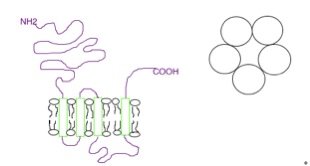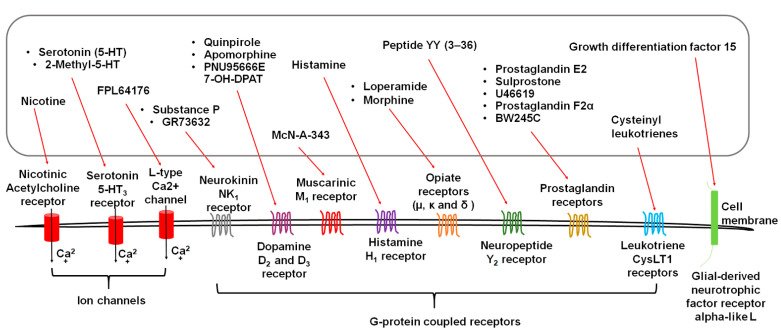How Does Nausea Work and How Do We Stop It?
Nausea and Emesis (vomiting) are not only uncomfortable experiences, but are important biological mechanisms to protect our bodies should we detect the injection of poisons and spoiled food.
As helpful as these responses are, it is an unfortunate fact that they are sometimes overactive and react incorrectly to non-harmful stimuli such as being on a boat or ingestion of psychedelics.
Nausea sucksSo…
How Does Nausea Work and How Do We Stop It?
There are numerous neurotransmitters and systems involved in the recognition of Nausea and the production of a vomit response. Of chief importance are Serotonin and the 5ht3 Serotonin receptor and Acetylcholine.
Serotonergic Nausea
We frequently think of Serotonin as a psychoactive mood regulating neurotransmitter primarily used in the brain, but in actuality, more than 95% of your serotonergic activity happens in the GI tract! [salsa] (I recommend a read of Serotonin, is it Really the Happiness Chemical? for more information about serotonin).
As discussed in previous articles, Serotonin is one of the most overloaded neurotransmitters out there, and has countless functions across different bodily systems and different species.
Similar to how it can trigger grasshopper metamorphosis into locusts, serotonin also has an interesting effect of being the byproduct of various harmful microbe’s metabolism. Due to this fact, our bodies have evolved a mass density of 5ht3 receptors in the GI tract to help to detect the presence of excess serotonin.
Once excessive serotonin is detected, more and more 5ht3 receptors become activated, eventually sending a nausea signal to the brainstem. In this pathway, Serotonin works in concert with the neurotransmitter Substance P (which is also heavily involved in the transmission of pain). [source]
These signals are eventually processed by the Dorsal Vagal Complex where the sensation of Nausea and the impulse for Emesis (vomiting) is created. [sauce]
5ht3 Receptor SubunitsBlocking Serotonergic Nausea
Now that we have a (very) rough understanding of how serotonin triggers nausea, let’s look at how we can defend against this.
The primary way to block nausea from 5ht3 is simple: a 5ht3 receptor antagonist. There are a series of drugs classed as the “setrons”, that all act as competitive 5ht3 receptor antagonists. Examples include Ondansetron (gold standard for chemo induced nausea), Dolasteron, Granisetron, etc.
Competitive Antagonists
As competitive antagonists, these setrons bind directly to the “orthosteric” site (meaning the site that serotonin normally would be binding to), thereby competing with serotonin, and making it harder for serotonin to find a receptor to attach to. Although this can be very effective in reducing nausea, its competitive nature has one inherent weakness: Since it simply competes with the agonist, given a large enough concentration of the agonist (or having an agonist with significantly stronger binding affinity to the 5ht3 receptor), the agonist can “overcome” the effects of the setron.
Think of this as playing teamed musical chairs. If a rival team is already sitting on half the chairs, your team will have a harder finding enough chairs to sit on. However, if your team is just way more nimble in running to a chair (has a much higher binding affinity) or if your team simply has way more people than the rival team, your chances of grabbing more chairs significantly increases.
The only way to counter this downside is ingestion of progressively more setrons. Though setrons are generally extremely safe for most patients, there is some risk of cardiovascular issues (such as QT prolongation) for some, so care should still be exercised.
[Source]
Ondansetron aka ZofranNoncompetitive Antagonists
We discussed this briefly in a previous article, but Ginger contains numerous forms of Gingerole, which typically act as noncompetitive antagonists at 5ht3.
As a review, the way noncompetitive antagonists work is by attaching to a separate “allosteric” site on the receptor, and completely disabling the receptor afterwards. Even with an extreme excess of high binding affinity agonists, they cannot “overwhelm” the effect of ginger, because the agonist can only bind to the orthosteric site, and has no way of kicking out the ginger that’s attached to a separate site. Binding at these allosteric receptors can also lead to chemical changes in the receptor, permanently disabling it (no worries though as your brain is constantly replenishing receptors, and this effect will only last a short amount of time).
Think of this as a game of musical chairs, except the rival team simply stole took a sledgehammer and destroyed every single chair regardless of whether you are already sitting on it or not. No matter how many people you have on your team, you cant possibly win this game of musical chairs if all the chairs has been crushed into bits.
Research suggests that coadministration of ginger and ondansetron leads to best efficacy. [pasta]
Gingerol, One of the Active Components of GingerAcetylcholine Nausea Transmission
New research has shown that the neurotransmitter Acetylcholine is heavily implicated in the transmission of nausea signal and in producing the nausea and vomiting response.
Nausea inducing triggers cause acetylcholine producing neurons to emit acetylcholine into the “vestibulocerebellar region” of the “posterior cerebellum”. In this region, acetylcholine defuses into the cerebrospinal fluid (CSF), which is the fluid that most of your central nervous system is bathed in. Eventually, these make their way into the brainstem and activate the “emetic center”, which triggers the sensation of nausea and the vomit response. [source]
Blocking Acetylcholine Transmission of Nausea
Due to Acetylcholine’s significant role in the transmission of nausea, we can easily target this pathway with drugs that block acetylcholine activity. Anticholinergic medicines such as first generation allergy medication (diphenhydramine aka Benadryl for example). Of special note is dramamine, which is an anticholinergic medicine that is specifically targeted at motion sickness. Dramamine is Dimenhydrinate, a compound similar to Diphenhydramine which blocks the muscarinic acetylcholine receptors. (See the article on drug classes to find out the dangerous hallucinogenic properties these can have at high dosages).
Example Drugs
Dimenhydrinate (Dramamine), Diphenhydramine (Benadryl), Scopolamine, Atropine, Hyoscyamine, etc
Note: Interestingly enough, some muscarinic acetylcholine antagonists are ALSO 5ht3 antagonists, allowing for double the nausea blocking effects: https://www.ncbi.nlm.nih.gov/pmc/articles/PMC4920643/
Summary of Other Emetic Ligands
We won’t have time today to go over all the numerous other ways nausea and vomiting can be triggered. Here is a summary of all the receptors that can have emetic effects. We will go over some of these in the future.





